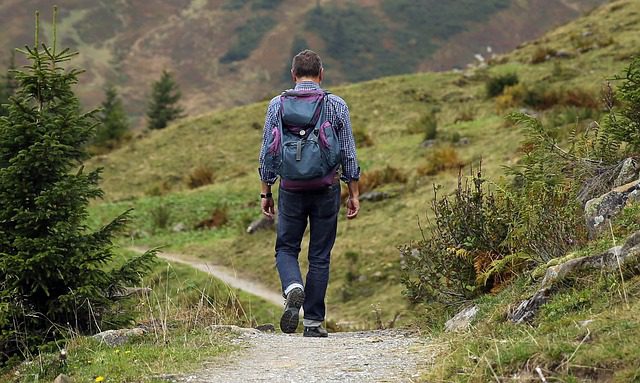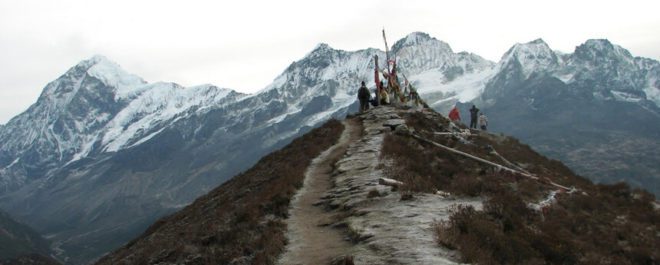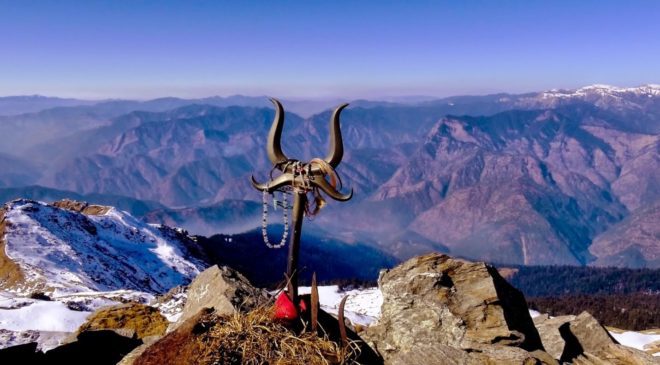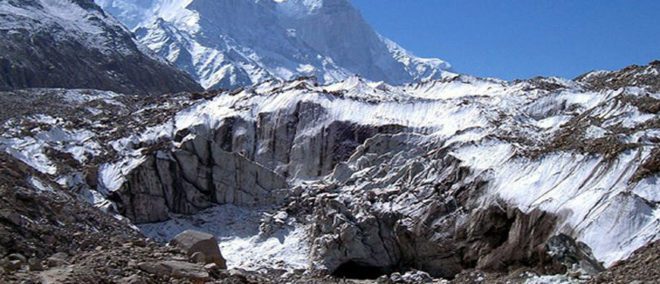7. Dzongri-Goecha La Trek
Area: Sikkim
Altitude: 4984mts
The most popular, the most demanding and the finest trekking destination’s in Sikkim, an absolute classic, this trek gives us breath-taking views of Kanchenjunga, apart from many other smaller peaks which surround it. It is surrounded by rich flora and fauna; the trail follows the Rathong Valley to Bakhim and then brings a steep ascent to the village of Tsokha. One can see the breath-taking sunrise at Dzongri and climb up to the vast grassland at Thangsing. Also one gets to visit Yuksom that once served as the capital of Sikkim. Best time to visit this trek is in months of March-May and September- November.
How to plan a trip to Dzongri-Goecha La Trek?
Day 1 Delhi – Bagdogra – Gangtok
Take a morning flight from Delhi to Bagdogra. Meet our representative and drive towards Darjeeling. On arrival transfer into the hotel. Evening sightseeing and acclimatization. Dinner and overnight stay at the hotel.
Day 2 Gangtok – Yuksom
Today we will drive to Yuksom. The base of our trek. Dinner and overnight stay in guesthouse/tents.
Day 3 Yuksom – Tshoka
The trail from Yuksom starts at the local market and follows the main road towards the north. The trail climbs gently out of the valley and hugs the right bank of the Ratong Chu River, which can be heard thundering through the gorge below. The trail crosses over four bridges to climb steeply towards north-west to the small settlement of Bakhim. Continue for another 3 km through a forest of magnolia and rhododendron to reach Tshokh. On arrival set campsite for dinner and overnight stay.
Day 4 Tshoka – Dzongri
On this day the trail passes through the village of Tshokh and continues to climb north through the forest of rhododendron to the alp of Phidang (3650 m) taking around 3 hrs to complete the ascent. Continue further towards Dzongri. On arrival set campsite for dinner and overnight stay.
Day 5 Dzongri Acclimatization
The day is for rest and acclimatization. On this day one can savour views of the mountain peaks by climbing up to Dzongri Top. From here you get a panoramic view of Kabru (7353 m), Ratong (6678 m), Kanchenjunga (8534 m), Koktang (6147 m), Pandim (6691 m) and Narsing (5825 m). Towards the west, the Singalila Ridge, which separates Sikkim from Nepal, can be seen. Dinner and overnight stay in tents.
Day 6 Dzongri – Thangsing
The trail from Dzongri continues along the right bank of the river towards east. After cresting the hill the path drops into the valley and then crosses the bridge over the Prek Chu River. It’s an hour climb from the bridge to Tangsiing (3800 m) located on the slopes of Mt Pandim. Dinner and overnight stay in tents.
Day 7 Thangsing – Samiti Lake
The trail from Tangsiing climbs gently north and follows a stream and alpine meadows. About an hour above Tangsiing we reach Onglathang from where the superb view of the south face of Kanchenjunga can be seen. In order to capture clear views, one has to reach Onglathang early. The trail then skirts through a series of glacial moraines before crossing over meadows again and arrives at the emerald lake at Samiti. Dinner and overnight stay in tents.
Day 8 Samiti Lake – Goecha La – Samiti Lake
The climb to Goecha La begins with a gentle gradient eastwards for about half an hour and then later the steep ascent starts. The trail follows the glacial moraine north-east and then drops to a dry lake at Zemathang. A tough scramble over rocks and boulders with a rise of 400 meters will bring us on the top of the pass. The pass is formed due to the depression between Pandim and the Kabru spurs. It overlooks the Talung Valley and commands a very impressive view of the south face of Kanchenjunga. Afternoon return to the Samiti Lake. Dinner and overnight stay in tents.
Day 9 Samiti Lake – Tshoka
Start retracing steps towards Tangsiing will take about a couple of hours or so. From Tangsiing follow the trail to Kokchorung (3800 m) which is a good camping site. Continue descending towards Tsokha by going through a bypass route directly to Tsokha. Dinner and overnight stay in tents.
Day 10 Tshoka – Yuksom
In the morning after breakfast trek down to Tshoka. Overnight stay at Guest House.
Day 11 Yuksom – Bagdogra
In the morning after breakfast drive to Bagdogra airport and from here catching a flight for onward destination.
8. Kedarnath Summit
Area: Garhwal Himalaya
Altitude: 6940mts
One of the auspicious places of Lord Shiva in India. Kedarnath peak is moderate as well difficult to challenging peak. During the climb, expeditions have to go through rock, ice walls, crevasses, and other extreme conditions. Panoramic views and scenic beauty of Himalaya is seen en-route. Kedarnath and Kedarnath Dome were first climbed together, in 1947, by a Swiss team led by André Roch.
How to plan a trip to Kedarnath Summit?
Day1 Delhi – Rishikesh
In the morning after breakfast drive to Rishikesh via Haridwar. On arrival check-in the hotel. The evening is free to explore the nearby area.
Day2 Rishikesh – Uttarkashi
The morning after breakfast proceeds for Uttarkashi. Upon arrival check-in at the Hotel. Evening free to explore the surroundings.
Day3 Uttarkashi
The day is for documentation. One can explore this beautiful hill town. Overnight at hotel.
Day4 Uttarkashi – Gangotri
The morning after breakfast drive to reach Gangotri via Harsil. On arrival check into Hotel. Overnight stay.
Day5 Gangotri – Bhoj Kharak
The day begins with a steep hike through fir forests before traversing the Kedar Gorge to reach camp. We will trek 8 km (5-6 hrs) as we follow the Kedar Ganga (Lord Shiva contribution to Bhagirathi), all the while enjoying the thundering sound of the river emerging from Kedar Tal. Night stay in tents.
Day6 Bhoj Kharak – Kedar Kharak
Trek 4 km passing through a beautiful birch (Bhoj) forest, before departing from the tree line and arriving at camp. The Bhirgupanth peak provides a nice backdrop as one make way across the long meadow, where the shepherds come to graze their sheep and goats. The day is short in distance, but it has its steep sections, so pace you. Overnight stay in tents.
Day7 Kedar Kharak – Kedar Tal
The 5km trek up to Kedar Tal is considered to be laborious and crosses very difficult terrain of boulders and stones. It is a maze of rocks and relatively easy to get turned around, but if you look closely you will see little cairns that have been placed on the route to the lake. Kedar Tal is one of the most enchanting glacial lakes with the majestic Thalayasagar looming up behind it. Thalayasagar, a quartz mountain, is also known as Sphatik (quartz) and is truly a delight to see at sunset! Overnight stay in tents.
Day8 Kedar Tal – Bhoj Kharak
Be sure to get up extra early to catch the magnificent sunrise and reflections off of the lake and surrounding peaks! Trek 9km back down to Bhoj Kharak, with the awe-inspiring memory of Kedar Tal, still etched in our mind. Night stay in tents.
Day9 Bhoj Kharak – Gangotri
In the morning after breakfast trek down to Gangotri. Night stay at Guest House.
Day10 Gangotri – Bhojwassa
The morning after breakfast trek further to Bhojwassa via Chirbasa (3600mt). From Gangotri, we move along the beaten track towards Chirbasa, which is on the tree line. The entire trek is along the roaring Bhagirathi River. Beyond Chirbasa the terrain becomes really desolate and barren. In fact, it has been referred to as Arctic Tundra by many trekkers. From Chirbasa trek further to Bhojwassa, the entire trail passes through dense forest, Arrive Bhojwassa; there are a small temple and a potential campsite near down the river. Make camp near Riverside. Afternoon free to explore the area and to enjoy the excellent sunset on Bhagirathi group of peaks. Night stay in tents.
Day11 Bhojwassa – Gomukh – Tapovan
Early in the Morning enjoy the panoramic view of the Bhagirathi group of peaks. After breakfast trek to Gomukh (3890mt), the source of the Ganges. Gomukh is where the water of Ganga trickles down from the glaciers. The sages called it ‘Gomukh’ because, in the distant past, it probably appeared like a cow’s mouth. Explore the area and trek to Tapovan, one of the finest high altitude alpine meadows in the area. The trek from Gomukh to Tapovan is ascent steep, and as we climb, the view of the surrounding peaks becomes clearer. They appear to be just a stone’s throw away. Tapovan known for its beautiful meadows that encircle the base camp of the Shivling peak, Tapovan is a very pleasant surprised spot with a large meadow complete with bubbling streams, wildflowers and campsites. Herds of Bharal (blue mountain goats) is a common sight from here on mountain ridges. On the far side of the glacier the Bhagirathi I, II, III (6454mt), provide an equally impressive backdrop. It is also the little wonder where Sadhus and saints choose this spot for extended meditation during the long summer month. Arrive Tapovan and camp. Night stay in camp.
Day12 Tapovan
Free to acclimatize, relax and enjoy the magnificent snowcapped peaks, flora & Fauna and mountain landscape. Night stay at the camp.
Day13 Tapovan – Base Camp
After early breakfast set out for base camp. At night stay in a tent.
Day 14 – Day 19: Climbing to Kedarnath Peak
from day 15 – day 19 approach to summit the Kedarnath peak.
Day 20 Tapovan – Chirbasa
After breakfast trek down to Chirbasa via Bhojwassa. Night in a tent.
Day 21 Chirbasa – Gangotri – Uttarkashi
After breakfast trek down to Gangotri and from here drive to Uttarkashi. Night stay.
Day22 Uttarkashi – Rishikesh
Day24 Rishikesh – Delhi
9. Gangotri Gomukh Trek
Area: Garhwal Himalaya
Altitude: 4465mts
It is one of the popular as well as gratifying treks of Uttarakhand, as it is the mouth of holy river Ganga. Located at the base of the Gangotri glacier, On the other hand, Tapovan is located above the Gangotri glacier. So, basically, this trek will pass through the glaciers. For all adventure lovers, this is the best trek to do. Best time to do trekking is in the months of May-June and August-October.
How to plan a trip to Gangotri Gomukh Trek –
Day1 Delhi-Haridwar
Day 2 Haridwar-Gangotri
Drive 245 km to reach the Gangotri via Uttarkashi and a beautiful valley Harsil. En-route take a holy dip in Gangnani hot water springs. Arrive at Gangotri by evening.
Day3 Gangotri-Bhojwasa
command your trek further to Bhojwasa via Chirbasa (3600mt). From Gangotri move along the beaten track towards chirbasa which is on the tree line. The entire trek is along the roaring Bhagirathi River. Beyond chirbasa the terrain becomes really desolate and barren. In fact, it has been referred to as Arctic Tundra by many trekkers. From chirbasa trek further to Bhoibasa, the entire trail passes through dense forest, Arrive Bhojbasa; there are a small temple and a potential campsite near down the river. Make your camp near the riverside.
Day4 Bhojwasa-Gomukh-Tapovan
Early in the Morning enjoy the panoramic view of the Bhagirathi group of peaks. After breakfast trek to Gomukh (3890mt), the source of the Ganges. Gomukh is where the water of Ganga trickles down from the glaciers. The sages called it ‘Gomukh’ because, in the distant past, it probably appeared like a cow’s mouth. Explore the area and trek to Tapovan. The trek from Gomukh to Tapovan is ascent steep, and as we climb, the view of the surrounding peaks becomes clearer. It appears to be just a stone’s throw away. Tapovan known for its beautiful meadows that encircle the base camp of the Shivling peak, Tapovan is a very pleasant surprised spot with a large meadow complete with bubbling streams, wildflowers, and campsites. Herds of Bharal (blue mountain goats) is a common sight from here on mountain ridges. On the far side of the glacier the Bhagirathi I, II, III (6454mt), provide an equally impressive backdrop. It is also the little wonder where Sadhus and saints choose this spot for extended meditation during the long summer month. Arrive at Tapovan and camp. Dinner and overnight stay in camp.
Day5 Tapovan -Nandanvan
We trace back to Nandanvan via Gomukh glacier. The route from Tapovan leads from the upper section of the meadow till down and onto the glacier. From Gomukh turn towards Nandanvan (4340m) and steering on right one will be on top of the Gangotri glacier. The glacier runs between two ranges and the landslides make a layer of rocky moraine on the ice which makes the walking easier. The glacier walk is very slippery and a slight lack of concentration would be dangerous. Huge crevasses gaped here and there. After walking, for about a kilometer there is a vertical ascent. Big rocks en-route offer grips and footholds but many of them are deceptive too.
Day6 Tapovan
Free to acclimatize, relax and enjoy the magnificent snowcapped peaks, flora & Fauna and mountain landscape.
Day8 Nandanvan – Bhojwasa
Early morning enjoys the sunrise on high peaks. After breakfast trek down to Bhojbasa. Arrive at Bhojbasa and camp.
Day9 Bhojwasa-Gangotri-Uttarkashi
The morning after breakfast trek down to Gangotri then drives to Uttarkashi.
Day10 Uttarkashi-Haridwar
The morning after breakfast drive to Haridwar.
Day11 Haridwar-Delhi





1 comment
Mind if I FR you on FB?|